Key takeaways:
- Building trust is essential in remote management; sharing vulnerabilities fosters connections within the team.
- Effective communication strategies, such as regular check-ins and encouraging feedback, enhance team dynamics and accountability.
- Utilizing collaborative tools like project management software and cloud storage improves transparency and productivity in remote work.
- Fostering team engagement through social activities and recognizing individual efforts significantly boosts morale and strengthens relationships.
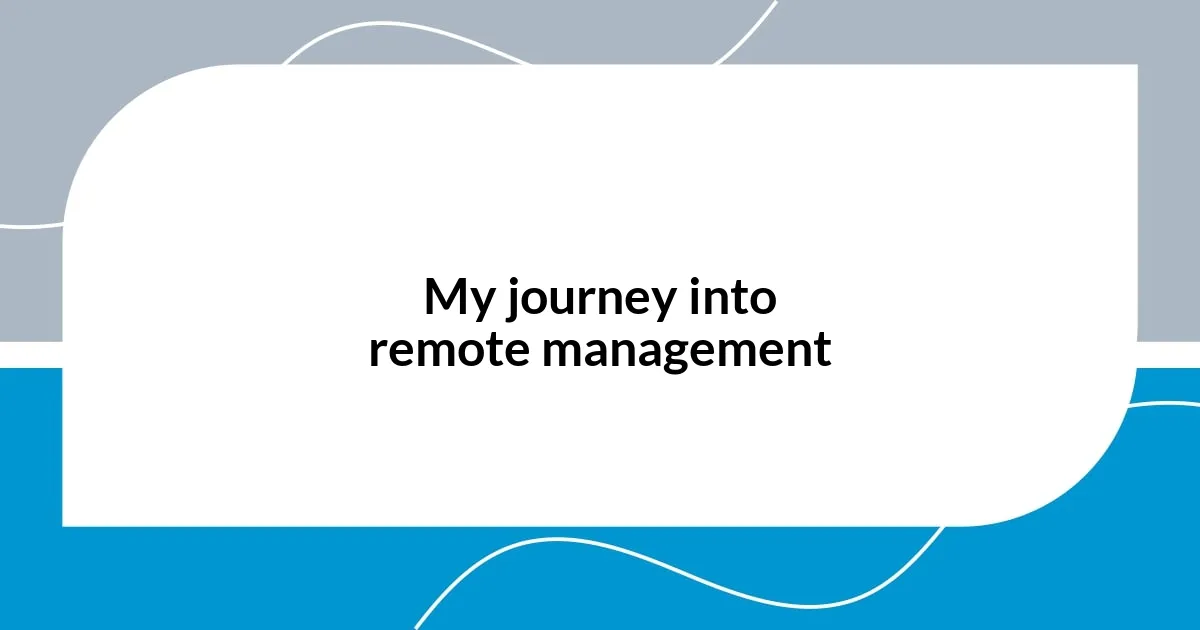
My journey into remote management
Transitioning into remote management was both exhilarating and daunting for me. I still remember my first video call with the team; my heart raced as I scanned their expressions on the screen, hoping to connect despite the distance. Did they find me relatable, or was I just another faceless figure in their digital world?
As I navigated through this new landscape, I learned the importance of building trust. I would often share personal stories during our team meetings—like the time I mismanaged a project because I underestimated communication. These moments revealed my vulnerability and helped cultivate a sense of camaraderie among my team. How can you expect to lead if your team doesn’t know the real you?
Over time, I discovered that fostering a remote work culture required creativity and dedication. I initiated virtual coffee breaks, bringing the team together to chat about anything but work. I vividly recall one session where a member shared their passion for baking, which sparked a delightful exchange of recipes. It struck me: despite the miles between us, we could still create a warm, supportive environment. Isn’t that the essence of effective management?
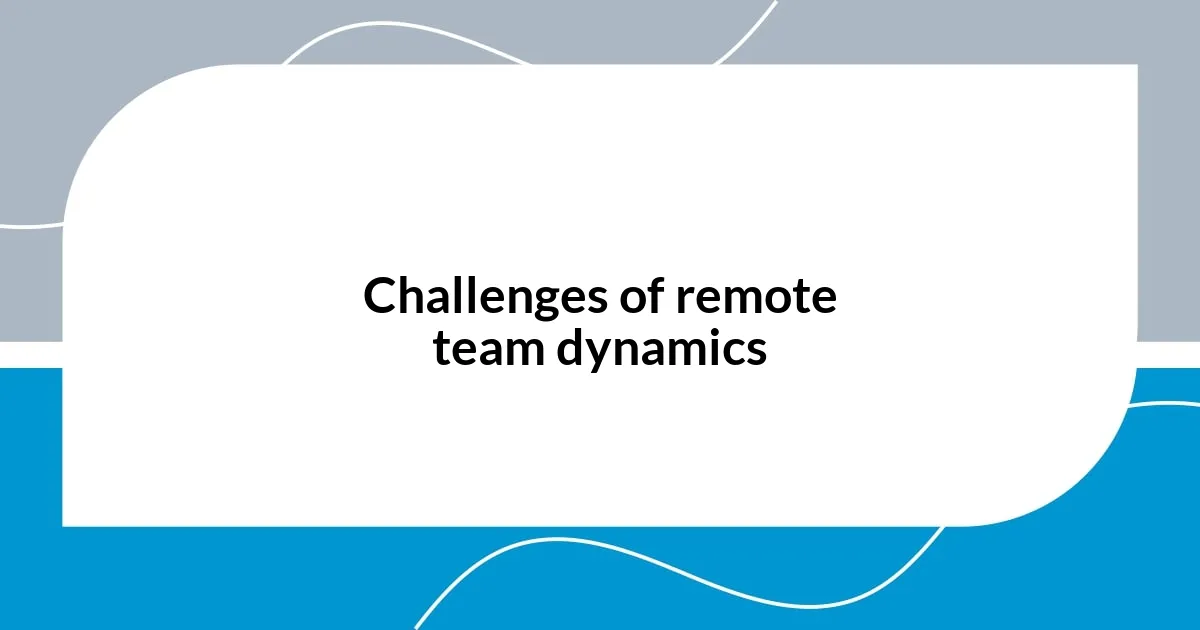
Challenges of remote team dynamics
One significant challenge I faced in remote team dynamics was the sense of isolation that often crept into our interactions. I remember a project where team members worked diligently yet silently, and it felt like we were all islands in a vast ocean. I quickly realized that without regular check-ins, people could feel disconnected and undervalued. Encouraging open dialogue became essential, as it was in those candid moments that real connections flourished.
Another hurdle was the diverse working styles and time zones of my team. I once scheduled a brainstorming session for 9 AM my time, only to find that it was the middle of the night for one of my members. It was a stark reminder that flexibility is key in remote management. I began to appreciate the value of asynchronous communication and started using collaborative tools that allowed everyone to contribute when they were most productive. This approach not only respected their time but also boosted our collective creativity.
Lastly, I often found that technology could become a double-edged sword. While tools like video conferencing and project management software kept us connected, they sometimes caused frustration. I recall a team meeting where poor internet connectivity interrupted our discussion multiple times, leading to a breakdown in communication. This experience underscored the importance of having backup plans in place. By implementing clearer guidelines and ensuring everyone had access to stable tech resources, we learned to navigate these challenges together.
| Challenge | Impact |
|---|---|
| Isolation | Reduces team morale and connection |
| Diverse working styles | Causes misalignment and scheduling conflicts |
| Technology issues | Leads to frustration and communication breakdowns |
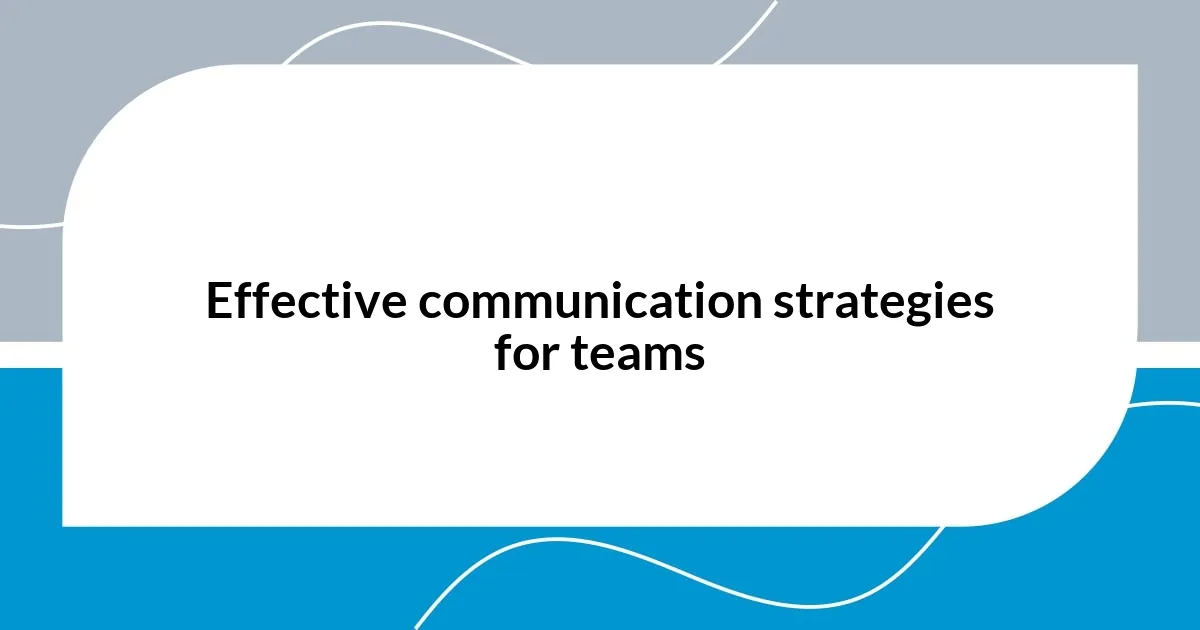
Effective communication strategies for teams
Effective communication is the lifeblood of any remote team. In my own experience, I’ve found that establishing regular stand-up meetings transformed our workflow. Initially, these quick daily check-ins felt redundant, but they became a cherished part of our routine. It was during one of these calls that a teammate shared how a misunderstanding led to an overlooked client request. By addressing it candidly, we not only resolved the issue but also reinforced a culture of transparency. I realized that when my team felt safe speaking up, it drove innovation and accountability.
To enhance communication further, I implemented a set of strategies that truly made a difference. Here’s a quick list of tactics I encourage teams to embrace:
- Utilize multiple channels: Leverage tools like Slack, Zoom, or Microsoft Teams for different types of conversations—formal updates, casual chats, and brainstorming sessions.
- Set clear expectations: Communicate not just what needs to be done, but also the type of updates and feedback you’re looking for from team members.
- Encourage feedback loops: Create an environment where continuous feedback is welcomed. It can be as simple as a quick “What can I improve?” at the end of meetings.
- Celebrate wins: Acknowledge individual and team accomplishments to keep morale high and reinforce a sense of belonging.
- Be there emotionally: Sometimes, just asking how someone is doing can lead to more authentic discussions about their work challenges or personal hurdles.
These strategies have helped me turn potentially awkward interactions into meaningful exchanges. By being proactive and considerate, I’ve noticed how team dynamics shift toward a more positive and collaborative culture.
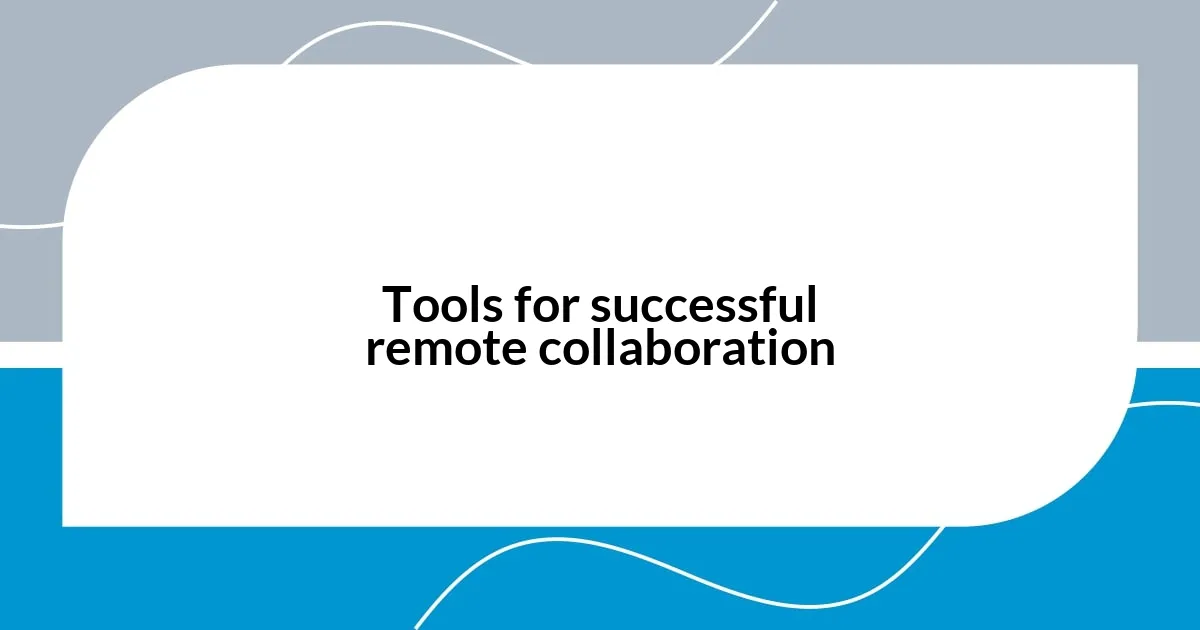
Tools for successful remote collaboration
When it comes to tools for successful remote collaboration, I’ve discovered that the right technology can truly transform a team’s dynamics. For instance, using platforms like Asana or Trello not only helps in tracking tasks but also brings clarity to what everyone is working on. I remember feeling overwhelmed with where projects stood, and once I implemented these tools, everything became more transparent. It’s like having a roadmap where everyone can see the journey and contribute without stepping on each other’s toes.
Another game-changer has been using video conferencing tools like Zoom. I found that seeing each other’s faces during discussions fosters a sense of connection that text cannot replicate. During one memorable meeting, a teammate shared their pet was having a rough day, which opened a light-hearted conversation and brought a more personal touch to our work. It made me realize how important it is to create a space where people feel comfortable sharing not just work updates but also snippets of their lives.
Lastly, incorporating cloud storage solutions like Google Drive has streamlined document sharing immensely. I used to dread the endless back-and-forth emails with attachments. Now, everything is organized, and the real-time collaboration allows us to work on documents simultaneously—much like we were in the same room. This accessibility has not only cut down on frustration but also skyrocketed our productivity. Why struggle with outdated methods when there are tools that can elevate the entire experience? Each of these tools has become a vital part of my remote management toolkit, and I can’t imagine working without them now.

Building trust in remote teams
Building trust within remote teams is often a gradual process, but I’ve found that vulnerability plays a pivotal role. One time, I shared a mistake I made with a project deadline during a team meeting. It wasn’t easy to admit my error, but the ripple effect was remarkable. Team members began to open up about their challenges as well, and together we forged a more honest atmosphere. Have you ever experienced that shift where admitting a flaw actually brings people closer? I truly believe that showing vulnerability invites others to do the same.
Another key aspect of trust-building is consistency. I recall an instance where I implemented a regular feedback session, not just for performance but to understand how everyone felt about our work environment. At first, some were hesitant, thinking it was a chore. However, after a few sessions, I saw the transformation. The team started sharing their thoughts enthusiastically and began trusting that their opinions mattered. Isn’t it incredible how little changes can invite big responses? I was amazed at how such openness blossomed into a strong bond among us.
Moreover, I learned the importance of being present, even in a virtual setting. One day, I made it a point to join a casual coffee chat with my team—no agenda, just conversation. It turned out to be one of the best decisions I made. We discussed everything from weekend plans to personal goals, which solidified our connections. It reminded me that trust isn’t built solely on work performance; it flourishes when we see each other as whole individuals. How often do we prioritize these human connections in our busy schedules?
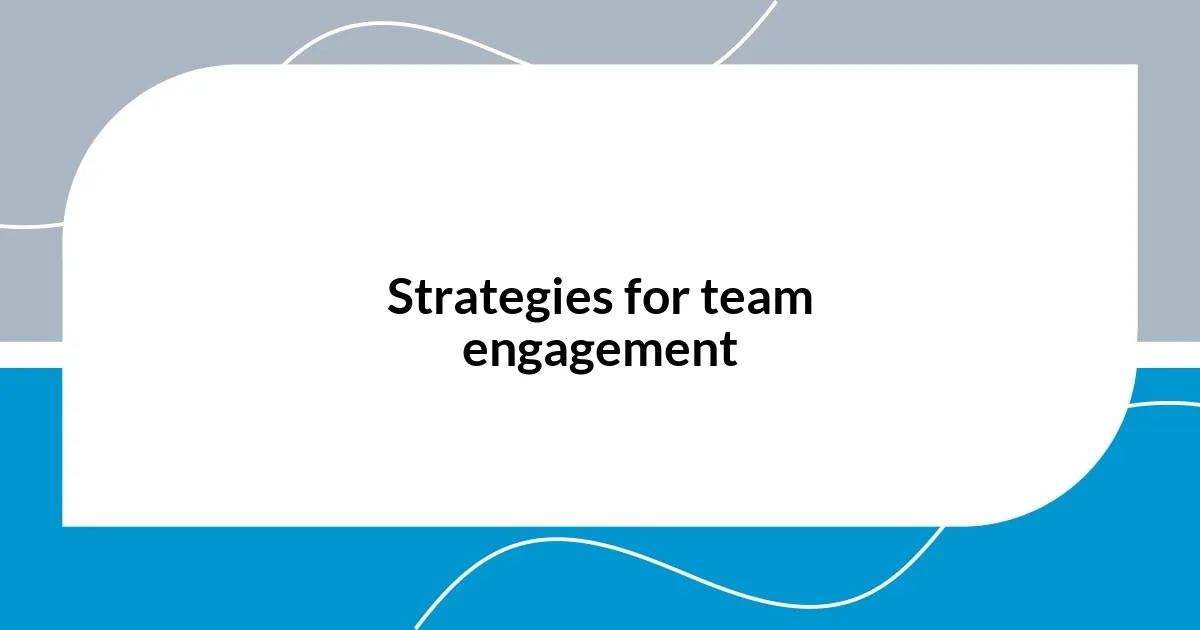
Strategies for team engagement
Encouraging team engagement in a remote setting can be quite the puzzle, but I’ve discovered that fostering a sense of community goes a long way. For instance, I introduced a “shout-out” channel on our communication platform where team members can recognize each other’s efforts. Initially, it felt a bit awkward, but once we got started, the positivity began to snowball. Have you ever noticed how a simple acknowledgment can uplift someone’s motivation? It certainly transformed our work atmosphere into one filled with encouragement and support.
In addition to recognition, incorporating regular social activities has proven to be an effective strategy. I remember hosting a virtual game night, something I thought would be a one-time experiment. To my surprise, it turned into a monthly highlight! Watching my colleagues laugh and interact outside of work tasks reminded me that we’re not just a team; we’re individuals with interests and personalities. Isn’t it refreshing to break away from the usual discussions about deadlines and deliverables? Creating these light-hearted moments has not only strengthened our bonds but also enhanced our overall teamwork.
Moreover, I’ve found that empowerment through autonomy significantly boosts engagement. When I transitioned from micromanaging to allowing my team to take ownership of their projects, I saw a remarkable shift. One team member, who had been hesitant to share ideas, suddenly took the lead on a project and exceeded all expectations. It made me realize that giving people space to excel is crucial. Have you noticed how much more inspired you feel when you’re trusted to make decisions? I’ve learned that with the right balance of support and freedom, team members become more invested in their work.

Measuring team performance remotely
Measuring team performance remotely can be tricky, yet it has become a key part of how I manage my teams effectively. One tool that I found particularly useful is project management software, which not only tracks progress but also offers a clear visualization of where the team stands with deadlines. I remember when we first started using it; the transparency it brought made everyone more accountable. It’s incredible how seeing tasks and deadlines laid out visually can change our productivity levels—have you ever noticed how a little clarity can lead to big results?
Regular check-ins have been instrumental in gauging performance, too. I initiated brief weekly one-on-one meetings with each team member. At first, I thought they might feel like formalities, but to my surprise, they became a safe space for honest feedback and discussions about challenges. I recall one of those meetings where a team member expressed feeling overwhelmed with their workload. Adjusting their assignments based on that conversation not only improved their performance but also demonstrated that their well-being mattered to me. Connecting emotional insights with performance measurement truly worked wonders. How often do we take the time to listen actively?
Another essential aspect is setting clear, measurable goals. When I shifted from vague expectations to SMART goals—those that are Specific, Measurable, Achievable, Relevant, and Time-bound—I saw a significant change in my team’s focus. For instance, instead of saying, “Let’s improve our customer feedback,” I would articulate, “Let’s increase our positive customer feedback ratings by 20% in the next quarter.” This clarity motivated my team to innovate and strive for success. It’s fascinating how having explicit targets can spark creative solutions—have you ever thought about how goal-setting shapes the mindset of your team?